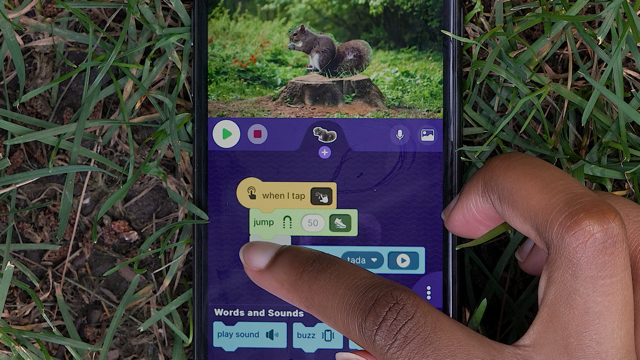OctoStudio Teaches Children to Code by Tinkering
Giving children projects with low floors, high ceilings, and wide walls allows them to creatively explore the world around them.
In his influential book Lifelong Kindergarten, Mitchel Resnick writes about projects with low floors, high ceilings, and wide walls. Seymour Papert developed the idea behind the first two: Low floors emphasize the importance of easy entry points, where barriers to engaging in activities or concepts are significantly reduced. High ceilings encourage learners to push their boundaries by offering opportunities for deep exploration and mastery. Resnick’s concept of wide walls opens a variety of possibilities for learners with diverse interests: “Children should be able to grow with their tools,” he wrote. Lego, the Scratch programming language, and Minecraft each have a low floor, a high ceiling, and wide walls for creative learning.
These are the principles that the Lifelong Kindergarten group at the MIT Media Lab has used to develop OctoStudio, a new, free coding app for children that works on mobile devices and tablets. Like Scratch, color-coded blocks can be interlocked in seconds and then react when a mobile device is tilted, moved, or tapped. As a low-floor tool, it is easy to learn. I spoke with Eric Schilling, one member of the OctoStudio team. “OctoStudio doesn’t do everything for you,” Schilling noted. “There’s a high ceiling and wide walls to tinker with it, too.” Tinkering is playful experimentation that can produce creativity.
3 OctoStudio Projects for the Elementary Classroom
There are myriad ways to utilize OctoStudio in the classroom, as Schilling and Ryoko Matsumoto from The Tinkering Studio, a prototyping space at the Exploratorium in San Francisco, shared with me. Rather than teaching coding as standalone lessons, The Tinkering Studio developed these projects as low-floor, high-ceiling, and wide-walls experiences where children learn through making and sharing projects. Each project can be adapted for your elementary classroom.
Wonder Walks to Introduce Science Topics: Using the low floor of importing images and narration on mobile devices, Schilling shared a fun lesson called “A Wonder Walk.” It builds on the idea of using KWL charts, a common introductory lesson in many elementary classrooms where teachers ask what students already know (K), wonder about (W), and will learn (L). "A Wonder Walk is an exploration of the space around you,” he said. Rather than chart paper or a whiteboard, turn the wonder and curiosity of a KWL chart into an opportunity for children to learn how to code while exploring the world around them. When walking around nature, have students take a photo and then tap a code block to add narration, where they record their questions over the image.

A Wonder Walk turns screen time into a nature walk or, as Matsumoto describes it, a “field trip with a purpose.” Schilling shared an example that can be adapted for any wondering. First, a child takes a picture of a tree stump. In OctoStudio, tapping that image allows you to hear that child say, “I wonder why that tree was cut down.” Another interactive image inquires, “I wonder why the moon is out during the daytime.”
Interactive Windows to the World: Tinker with a View is another project that can be mapped to elementary social studies content standards, in which students share research on the world outside. Start by bringing the class outside to take photos of their surroundings, either nature or the local community. You can also import images of faraway places. Young students can then snap together a couple of code blocks to animate the images. Next, using physical materials, have students cut out and decorate cardboard window frames. Placing the cardboard window frame over the screen culminates the activity, turning digital screens into windows of the world! More ways to adapt this project are in this presentation.
Tinkering With Books: There are many approaches that elementary teachers take to bring books to life, from fan fiction writing to acting out as characters in reader’s theater. OctoStudio can be used to create a low-floor, high-ceiling, and wide-walls opportunity to deepen reading experiences. For instance, Bring a Book to Life projects ask young students to take a picture of a character and a backdrop of their choosing from a picturebook and add that to an OctoStudio project. Next, narration, sound effects, and interactive elements are added.
One idea uses the board book Don’t Push the Button! by Bill Cotter. In the book, a purple monster named Larry tries to resist all temptations to push a red button. Children can take a picture of Larry and the red button. By simply adding a coding block to the red button sprite, the backdrop can be changed to coordinate with the narrative in the board book.
In a similar project, The Book with a Hole, by Hervé Tullet, is brought to life. As the title suggests, the book has a literal hole in its center, which can fit a smartphone when opened on a table or desk. Children can easily code interactions that change the objects that appear as the pages are turned.
In addition to picture books with fictional narratives, nonfiction projects can bring a science text to life, as students can make animated projects illustrating what they’ve learned.
OctoStudio is more than coding on a phone; rather, it is a tool for introducing interest-driven, project-based learning to children. Best of all, it is completely free. There are no accounts to create, no user data is collected, and it is available in more than 20 languages. With a low-floor, high-ceiling, and wide-walls tool like OctoStudio, what will your students create?
